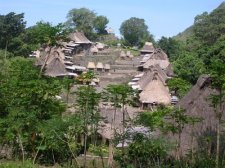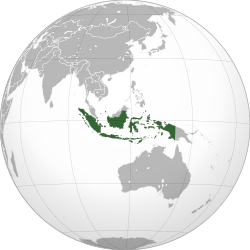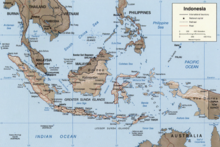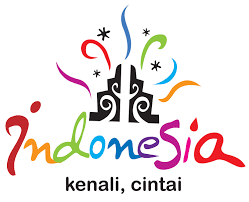Flores, beauty and the east
(PT. Majesty Holidays Medan)
 |
Larantuka : Land of the The Christian in Eastern Part of Flores Island Indonesia » |
Anett Keller, WEEKENDER Magazine (Jakarta Post) | Wed, 11/30/2011 3:15 PM |
Family Trip Experience.
Flores offers mountain tours, beaches and coral reefs, as well as a rich local culture reflected in the brilliant colors and varied patterns of traditional woven fabrics.
My daughter is bursting with excitement as she points out the car window. “Mom, look at that! The world is so big here!”
She’s absolutely right. We have just come from Java, one of the most densely populated regions of the world, and arrived in what appears to be another universe. Now and then, we encounter a village of simple wooden houses. Now and then, a pig runs across the street, or a few goats, whose bleating follows soon after. Apart from these “interruptions”, our view wanders along the road to the endless green of rice fields and forests, hills and volcanoes.
 |
| Labuan Bajo |
Most of the tourists to Flores arrive by plane at Labuanbajo, on the island’s westernmost tip, and go no further east, seeking only to see the famous Komodo dragons or maybe go diving. Yet the less well-known beauty of the island itself is well worth discovering.
| Ruteng, flores |
We want to get to know Flores, named so evocatively by Portuguese sailors, and helping us is Leonardus Nyoman, or Leo, an experienced guide and owner of Flores Exotic Tours. Ruteng, the capital of Manggarai Regency, is our first stop. For hours we bump along a road that assumes the somewhat pretentious title of the Trans-Flores Highway. This is a tour that the eyes enjoy much more than the stomach, as the trail switches back and forth through ridges and breathtaking scenery.
Wherever we look, our eyes are assaulted by the bright green splendor of terraced fields – as Leo explains, “The area around Ruteng is also called ‘the rice bowl of Flores’.”
This fertile area is also one of the largest coffee-growing regions in Indonesia. Ruteng, a bustling town with a pleasantly cool climate, is the perfect starting point for hiking tours into the countryside and for treks up the 2,400-meter-high volcano Mt. Ranaka or to the lake Rana Mese, whose bottom is visible through its crystal-clear waters.
Since 2003, Ruteng has had yet another attraction. That was the year Australian scientists discovered in the Liang Bua cave, about 15 kilometers north of the city, the skeleton of an early human being who was no taller than 100 centimeters. Known as Homo floresiensis – and dubbed “the hobbit” – this hominid lived around 18,000 years ago and is now the smallest known member of the genus Homo, which includes Homo erectus and Homo sapiens (i.e., us). The stalactite cave and the stories Leo tells us about the discovery, which helped write history, make us marvel as we imagine the world in those prehistoric days.
In the Spirit
 |
Bajawa |
We sweep ourselves back to the present and continue our drive eastward to Bajawa, “the traditional center” of Flores. Along the way, in Aimere, we get a glimpse of a very lively local tradition: the distilling of a spirit called moke. Twice a day, men climb the lontar palms to collect the juice running from the scored trunks. In earthenware pots and over an open fire, the moke is heated and distilled into long bamboo tubes. The “official” specification is 30 percent alcohol, which we suspect, taking our first sip, is a gross understatement.
We are here entering the region of the Ngada tribe. Although the Ngada people, like most inhabitants of Flores, now belong to the Catholic faith, they have retained their centuries-old traditions. Almost in every village, visitors will find traces of the ancient megalithic culture and shrines that symbolize masculinity (Ngadhu) and femininity (Bhaga). The village of Bena, picturesquely situated at the foot of the volcano Inerie, is a center of Ngada culture. Two rows of traditional wooden houses with elephant-grass roofs surround an area that serves as a cemetery and place of ancestral worship. This is also where the village elders – after engaging in their spiritual consultation with the ancestors – make important decisions.
As we enter the village, we witness a gathering that seems to involve the entire community, from the very youngest to the most senior. A new community center is currently under construction, for which one of the old family houses will be moved, leaving many details to be discussed. After the meeting, the families disperse and resume their places on the terraces of their houses.
The women are weaving colorful ikat. From their red-stained mouths, they spit betel-nut juice and gradually the floor in front of them turns red too. The men are busy at the construction sites. Among them, numerous children play.
“Tourism has helped Bena to gain some modest prosperity,” Leo tells us.
But, he adds, this unfortunately does not apply to all parts of the island of Flores. Despite its natural wealth, the area remains one of the poorest regions in Indonesia. Many farmers have no choice but to sell their produce to large trading companies, because local markets are insufficiently developed. These large buyers can drive down prices, leaving little profit for the producers, explains Leo. Poor educational opportunities and inadequate health care perpetuate the poverty trap.
Leo and his colleagues are trying to promote sustainable tourism in Flores. He organizes customized tours and draws his guests’ attention to environmental and social problems.
“Please don’t give money to begging villagers,” he says. “Purchasing their products will support the people of Flores in a more sustainable way.”
To this end, he and his family have established a foundation that helps dropouts from disadvantaged families to return to school.
From Bena, located almost at the southernmost tip of Flores, we cross the island toward the north.Riung Marine Park is our next destination. We set off very early in the morning for a boat trip through the “park of 17 islands”; there are actually more than 20 islands, but the name is a word play on Indonesian Independence Day – August 17. We are less interested in number games than the natural beauty the marine park has to offer.
Ontoloe, the largest of the park’s islands, is our first stop. Slowly, the boat approaches the northern mangrove-lined coast. What is that hanging in the tops of the mangroves? From afar, they look like large, dry leaves. The skipper starts clapping and shouting, and the leaves start flying – they are bats. There must be thousands. In a giant swarm they rise, the air reverberating with their humming and whistling.
The boat sails on and brings us into a realm of turquoise waters and white-sand beaches, the contrasting colors gleaming so brightly in the sunlight that we wonder whether we are dreaming. The boat stops at a deserted beach on an island called Pulau Tiga. We don our snorkeling gear and float in the shallow, warm waters, enchanted by the pristine underwater world of multicolored coral and fish.
Meanwhile, our companions have built a small fire from a few wooden sticks and serve grilled fish and rice. This is as close to paradise as it gets – or so we think at the time. Then we leave for the next island, called Rutong. The blazing midday sun beats down on a lonely, snow-white beach. Dozens of starfish dot the shallow turquoise water. A walk up a nearby hill affords a view over the perfectly curved bay below us and the sparkling sea extending along the north coast of Flores. Silently, intoxicated by the beauty of these islands and sedated by the serenity of the waves, we return to the port of Riung.
Table Setting
 |
| Nanga Panda |
Next morning, we’re heading southward, bumping for several hours along on a dusty road. Near Ende, on the southern coast of Flores, we stop at a beach called Nanga Panda. No white sand here – it is covered by turquoise stones polished by the sea. Several men and women are gathering the stones in large sacks. The collectors sell them – for only Rp 600 per kilogram – to merchants who ship them to Bali and Surabaya, where they make their way to homeware shops for uptown tastes. From the coastal road, we get a glimpse of bizarre Gunung Meja – or Table Mountain – which looks as if a giant with some uptown taste of his own has cut off its top to be able to dine comfortably.
| kelimutu |
The road takes us uphill again, into the mountains to the village of Moni, toward our next destination, the fabled Kelimutu. In the early morning, we travel by jeep to the slopes of the volcano. The summit is a pleasant walk of about one kilometer, fortunately not requiring the stamina of a seasoned mountain climber.
As dawn begins to break, we are sitting on top of the almost 1,700-meter-high mountain, grateful for our fleece jackets and the hot coffee, brought by vendors wrapped up in their woven ikat – up here, tropical temperatures no longer prevail. And we wait: Kelimutu does not always expose itself to visitors; it is often shrouded in clouds.
“Let’s see whether the spirits of the mountain are in a good mood,” Leo says with a wink.
Apparently they are. The rising sun greets us from a clear blue sky.
Little by little, the sun illuminates the three crater lakes of Kelimutu. Before us lies the turquoise Danau Tiwu Nuamuri Koofai. Behind it is Danau Tiwu Ata Pol, chocolate-brown (at the time of our visit; it has since changed to turquoise as well). Opposite is Danau Tiwu Ata Mbupu, which almost looks like a “normal” dark-green mountain lake. Locals believe that the souls of the dead reside in these lakes – the children in the turquoise and adults in the deep green – but only as long as they have not clocked up too many sins: the brown (now turquoise) lake is reserved for the evil souls.
We marvel at the surreal colors of the lakes in the morning light. My daughter – excited by the discovery that Pop-Mie sellers also manage to climb sacred mountains – distributes the carrots meant as her early morning snack to the monkeys loitering around the lakes. May that “offering” keep the spirits of the mountain merciful. They certainly seem to be rather sensitive. Whether the news of the day is droughts or political upheaval, a change of the colors of the lakes – according to local belief – foretells changes for the people too.
By late morning, we tear ourselves away from the cool mountain air and this mystical place to hike through the surrounding villages. Jopu seems to be home to more looms than human beings. Everywhere in the village, swathes of colorful ikat are spread out. They must be a calm people – weaving is not for impatient minds. The threads are tied and dyed by hand, although over time chemical dyes have replaced their natural predecessors in many places.
We meet Stefanus Dindu, a connoisseur of traditional colors and motifs, who sells old ikat fabrics in Jopu and shares his rich knowledge about the meaning and origin of the various patterns.
In Sikka on the south coast, too, all the women seem to have dedicated themselves to weaving. Immediately upon entering the village, we are surrounded by a gang of chattering women overwhelming the visitor until a purchase is made. We buy several scarves and a sarong and turn to Sikka’s other attraction: a wooden church at least a century old. We marvel at the interior walls painted with ikat patterns. With a beautiful cemetery in view, situated between the beach and the church and lined with palm trees, we start to muse about perfect final resting places.
Our journey is approaching its end. After we cross the island – in this section only about 20 km wide – and once more head north, Maumere is our last stop. Quietly in the afternoon sun, the waters lap at the dark beach. In a little wooden boat, a clam seller displays the wealth of the sea.
Our trip through the “Flower Island” was, in sum, spectacular. Those who are accustomed to the comforts of Bali might need some adjustments. Certainly, those who need luxury and the certainty of reaching destinations quickly will be pushed to their limits here. But those who prefer the straightforward friendliness of the local people and the breathtaking beauty of nature will fall in love with the flower island – and will be longing to return to the place where the world is just bigger.
Pt. Majesty Holidays Medan
Pt. Majesty Holidays Medan
















































